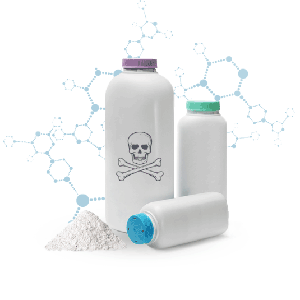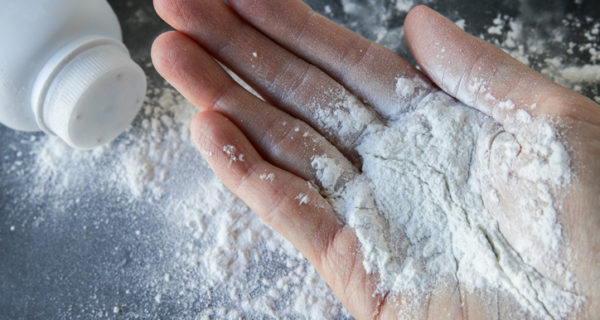Talcum Powder Side Effects & Potential Health Complications
 Consumers report some unpleasant talcum powder side effects and complications after long-term use. Depending on how long and where it’s applied, risks vary. However, medical studies link long-term talc use to increased risk for developing ovarian and cervical cancer. Since it’s easy to inhale airborne talc particles, talcum powder also poses a risk to babies.
Consumers report some unpleasant talcum powder side effects and complications after long-term use. Depending on how long and where it’s applied, risks vary. However, medical studies link long-term talc use to increased risk for developing ovarian and cervical cancer. Since it’s easy to inhale airborne talc particles, talcum powder also poses a risk to babies.
While ovarian cancer is the most common (and fatal) complication of prolonged talcum powder use, other side effects do exist. Talc particles are easily airborne, and inhaling talcum powder can cause coughing, wheezing, shallow breathing as well as a chronic lung condition called pulmonary talcosis. As a result, extended talc inhalation can cause pneumonia and trigger asthma symptoms. And talc in its natural form may also contain asbestos, a well-known carcinogen. The Federal Drug Administration banned marketing any talc-based products that contain asbestos to consumers. However, Johnson’s® baby powder. Asbestos exposure produces many unpleasant side effects, including mesothelioma and lung cancer. After FDA testing revealed asbestos in one lot of bottles in October 2019, the company voluntarily recalled them from store shelves. Then in May 2020, the company decided to stop selling talcum powder products to consumers forever.
Talcum Powder Side Effects & Complications for Women
Thousands of women sprinkle talcum powder into their undies daily to control odor and maintain a fresh, dry feeling. However, decades of research reports severe and even life-threatening complications from talcum powder, including certain cancers.
British researchers at a lab in Wales conducted the first study showing a clear link between ovarian cancer and talcum powder use in 1971. Researchers dissected 13 ovarian tumors, finding particles of talc “deeply embedded” within 10 of them. Since then, additional studies found that talc crystals traveled through a woman’s genitourinary tract into her peritoneal cavity. Once there, particles embed themselves into the woman’s ovaries. Because talc particles can take years to dissolve, inflammation around the area is common. And since all silicates like talc have inflammatory properties, many doctors believe it may explain the link between talcum powder and cancer.
Over 20 additional studies associate peritoneal talcum powder contamination with ovarian cancer. An American woman’s risk for developing ovarian cancer is currently 1 in 75, according to the OCRFA. Yet exposure to talcum powder increases those odds to 1 in 53, based on subsequent research. According to the CDC, about 20,000 U.S. women are diagnosed with ovarian cancer annually, and around 14,000 will die from it. As a result, ovarian cancer is the fifth-leading cause of cancer death in U.S. women. While radiation or chemotherapy treatments have temporary side effects, death is the worst possible outcome.
Talcum Powder Side Effects & Complications for Babies
Because it’s easy to inhale tiny airborne talc particles, most pediatricians warn new parents not to use it on their babies. Instead, use cornstarch-based baby powders to treat rashes and keep diaper-clad bottoms dry.
Dr. Jo Ann Rohyans says that “baby powder may smell and feel good, but I don’t recommend it — and the American Academy of Pediatrics also recommends against it. Powder can cause breathing problems and serious lung damage when inhaled, and it’s not always easy to keep the powder out of the air where your baby might breathe it.” Additionally, there’s no evidence that talc-based baby powder prevents rashes, despite marketing it to parents for that purpose.
And since inhaled talc dries out an infant’s mucous membranes, it may also cause serious lung damage. Dr. Andrew Weil says, “Some babies developed pneumonia and some have died as a result of respiratory failure from inhaling the powder. Cornstarch isn’t ideal either, but its particles are larger and are not as easily inhaled as talc.”
All Johnson’s baby powder and Shower-to-Shower® body powder products now warn that inhalation can lead to other talcum powder side effects. Because pouring talcum powder makes it easy to breathe in and airborne particles travel quickly, talc can get into the lungs and other openings in the body. As a result, some women face distressing side effects — including life-threatening cancer. In 2018, two mesothelioma plaintiffs won multimillion-dollar verdicts against J&J. The first was Stephen Lanzo III, who (along with his wife) won $117 million in April. A month later, a jury ordered J&J to pay Joanne Anderson $26 million for her terminal mesothelioma case. In the first half of 2019, three mesothelioma plaintiffs won a total of $355.4 million in damages.
Talcum Powder Side Effects May Include Mesothelioma, Ovarian Cancer
Finally, all possible carcinogenic side effects and complications remain largely unknown. The American Cancer Society acknowledges that since many products contain talc, consumers should decide whether it’s worth the risk. The ACS concludes that “research in this area continues,” since over 20 epidemiological studies list ovarian cancer among the known talcum powder side effect risks.
The biggest lawsuit involving 22 ovarian cancer plaintiffs alleged J&J products tested positive for asbestos. In July 2018, a jury awarded the group $2.12 billion in punitive and actual damages for talcum powder side effects. While J&J appealed the case, a second jury upheld the ruling and payment amount in August 2018.
Check your eligibility for compensation.
If you or a loved one has suffered from ovarian cancer after talcum powder use, you may qualify for compensation from the manufacturer. Request your free case evaluation now to see if you may qualify.
Lori Polemenakos is Director of Consumer Content and SEO strategist for LeadingResponse, a legal marketing company. An award-winning journalist, writer and editor based in Dallas, Texas, she's produced articles for major brands such as Match.com, Yahoo!, MSN, AOL, Xfinity, Mail.com, and edited several published books. Since 2016, she's published hundreds of articles about Social Security disability, workers' compensation, veterans' benefits, personal injury, mass tort, auto accident claims, bankruptcy, employment law and other related legal issues.




